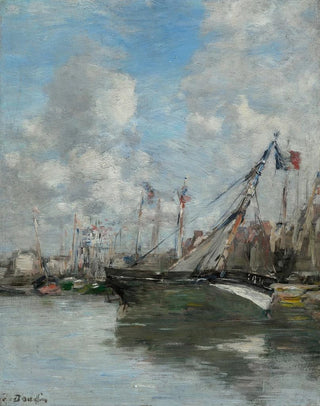Trouville Painting, stranded boats - Eugène Boudin | Art print


View from behind

Frame (optional)
Trouville Art print, stranded boats - Eugène Boudin – Captivating introduction
In the fascinating world of Impressionism, Eugène Boudin's "Trouville, stranded boats" stands out for its poetic and luminous depiction of the Normandy coast. This painting, which captures the very essence of a fleeting moment, evokes the beauty of marine landscapes while revealing the delicacy of interactions between humans and nature. The scene depicts stranded boats on the sand, witnessing a suspended moment where the sea, sky, and land blend in captivating visual harmony. Light plays a central role, enveloping each element in a vibrant and lively atmosphere, inviting the viewer to immerse themselves in this maritime reality imbued with serenity.
Style and uniqueness of the work
Eugène Boudin's style is characterized by a unique approach that combines realism and Impressionism, offering an authentic vision of the landscapes he so dearly loves. In "Trouville, stranded boats," one can observe his plein air painting technique, which allows him to capture natural light and subtle color nuances with remarkable precision. Brushstrokes are both fluid and controlled, creating a texture that brings the canvas to life. The soft hues of the sky are reflected in the water, while the boats, though static, seem to vibrate with the waves. Every detail is carefully considered, from cast shadows to shimmering reflections, revealing an emotional depth that transcends the simple maritime landscape. This work embodies Boudin's love for the sea and his ability to convey sensations through color and light.
The artist and his influence
Eugène Boudin, often regarded as a precursor of Impressionism, played a fundamental role in the evolution of art in the 19th century. Born in Honfleur in 1824, he was deeply influenced by the marine landscapes of his native region. His friendship with Claude Monet and other Impressionist artists helped shape his style, but it is his ability to capture the present moment that makes him unique. Boudin was a pioneer

Matte finish

View from behind

Frame (optional)
Trouville Art print, stranded boats - Eugène Boudin – Captivating introduction
In the fascinating world of Impressionism, Eugène Boudin's "Trouville, stranded boats" stands out for its poetic and luminous depiction of the Normandy coast. This painting, which captures the very essence of a fleeting moment, evokes the beauty of marine landscapes while revealing the delicacy of interactions between humans and nature. The scene depicts stranded boats on the sand, witnessing a suspended moment where the sea, sky, and land blend in captivating visual harmony. Light plays a central role, enveloping each element in a vibrant and lively atmosphere, inviting the viewer to immerse themselves in this maritime reality imbued with serenity.
Style and uniqueness of the work
Eugène Boudin's style is characterized by a unique approach that combines realism and Impressionism, offering an authentic vision of the landscapes he so dearly loves. In "Trouville, stranded boats," one can observe his plein air painting technique, which allows him to capture natural light and subtle color nuances with remarkable precision. Brushstrokes are both fluid and controlled, creating a texture that brings the canvas to life. The soft hues of the sky are reflected in the water, while the boats, though static, seem to vibrate with the waves. Every detail is carefully considered, from cast shadows to shimmering reflections, revealing an emotional depth that transcends the simple maritime landscape. This work embodies Boudin's love for the sea and his ability to convey sensations through color and light.
The artist and his influence
Eugène Boudin, often regarded as a precursor of Impressionism, played a fundamental role in the evolution of art in the 19th century. Born in Honfleur in 1824, he was deeply influenced by the marine landscapes of his native region. His friendship with Claude Monet and other Impressionist artists helped shape his style, but it is his ability to capture the present moment that makes him unique. Boudin was a pioneer
12,34 €






